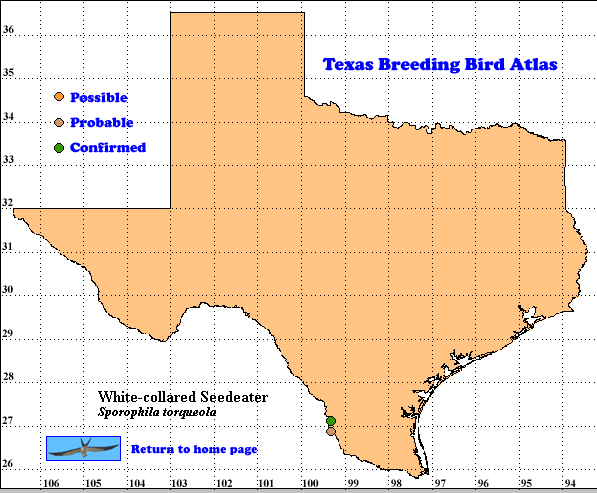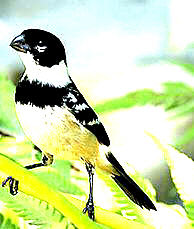The White-collared Seedeater is a frequently encountered member of the seed-eating guild from northern Panama to northeastern Mexico and southernmost Texas. At the peripheral edge of its range, in Texas, the species was once common but now is considered a rare summer resident (Lockwood and Freeman 2005).
In Texas breeding has historically been restricted to the lower Rio Grande Valley (Friedmann 1963, Bent 1968, Friedmann and Kiff 1989). Since 1946, however, the species population has precipitously declined with recent breeding records only from Zapata County (latilong 27099;.Eitniear and Rueckle 1995). Wintering records have been obtained from adjacent Starr and Webb counties but breeding activity is yet to be verified.
DISTRIBUTION: Once widely distributed from Laredo to Brownsville and up the Texas coast to Corpus Christi, the White-collared Seedeater is now considered rare (Oberholser 1974, Eitniear 1997, Lockwood and Freeman 2004). The known Texas distribution now centers around a small population near San Ygnacio (27099-A4) and Zapata (Ortego 1991a). Infrequent sightings of a few individuals have been recorded, in Falcon Darn Recreational Area (Arvin 1974) and nearby Fronton (Ortego 1991b), Southmost Ranch in Cameron County (Leslie and Jahrsdoerfer 1988), and Webb County (Arnold 1980, Mark Woodin, pers. comm.)
SEASONAL OCCURRENCE. The breeding season historically extended from April until July (Eitniear 1997). Recent nesting (recently hatched egg) has been documented in July (Eitniear and Rueckle 1996) with fledged young in August (Eitniear and Rueckle 1995). Of 19 nests recorded in Texas, 15% were found in April, 42% in May and 21% in June and July (Eitniear 1997). The 3 TBBA records are from May and June.
BREEDING HABITAT. Preferred nesting habitat in Texas includes riparian areas, especially in floodplains where herbaceous vegetation is dense. Nest sites include small trees and bushes (black willow, anacua, catclaw acacia). Nests have also been found in herbaceous vegetation (sunflowers, dock, aster and giant ragweed). Texas nests varied from 0.6 to 1.2 m (2-4 ft) above ground (Eitniear 1997). Nests are constructed of fine rootlets, fibers, cobwebs, palm leaf stripping, moss, leaves of grasses, strips of cloth and horsehair (Bent l968, Eitniear 1997). Seventeen nests examined in Texas contained either 3 or 4 eggs (Eitniear 1997).
STATUS: Decline of this species in Texas has been dramatically illustrated in data from annual Audubon Christmas Bird Counts (CBC). In 1949 only two delta counts were taken with 107 seedeaters counted. Since 1965 the number of CBCs has increased to 6 but only a single seedeater has been recorded (JCE). During 1995-96 from 7-9 pairs were observed in Zapata County (Eitniear 1997). An additional group was observed during the fall of 1996 in Webb County, upriver from Laredo (Mark Woodin pers. comm.). The possibly of breeding activity in Webb County requires verification. Text by Jack C. Eitniear (Posted with updates 2007).
 Literature cited.
Literature cited.
Arnold, K. A. 1980. Rufous-capped and White-collared Seedeater from Webb, County, Texas. Bull. Texas Ornithol. Soc. 13: 27.
Arvin, J. 1974. Birds of Falcon State Park, A Checklist (Revised edition) Texas Parks and Wildl. Dept., Austin.
Bent, A. C. 1968. Sporophila torqueola sliarpei Lawrence. Sharpe’s Seedeater. In Life histories of North American cardinals, grosbeaks, buntings, towhees, finches, sparrows and their allies, pp. 322-326. (0. L. Austin, Jr., ed.) U.S. Natl. Mus. Bull. 237.
Eitniear, J. C. 1997. White-collared Seedeater (Sporophila torqueola). In The Birds of North America, No. 278 (A. Poole and F. Gill eds.). The Birds of North America, Inc., Philadelphia, PA.
Eitniear, J., and T. Rueckle. 1995. Successful nesting of the White-ollared Seedeater in Zapata County, Texas. Bull. Texas Ornithol. Soc. 28: 20-21.
Eitniear, J., and T. Rueckle. 1996. Noteworthy avian breeding records from Zapata County, Texas. Bull. Texas Ornithol. Soc. 29(1).
Friedmann, H. 1963. Host relationships of the parasitic cowbirds. U. S. Natl. Mus. Bull. 233.
Friedmann, H., and L. Kitf. 1989. The parasitic cowbirds and their hosts. Proc. West. Found. Vertebr. Zool. 2: 229-304.
Leslie, D. M. and S. E. Jahrsdorfer. 1988. Tamaulipas Brushland of the Lower Rio Grande Valley of Texas: description, human impacts and management options. U. S. Fish. Wildl. Serv., Biol. Rep. 88(36): 63.
Lockwood, M. W. and B. Freeman. 2004. The TOS handbook of Texas birds. Texas A&M University Press, College Station.
Ortegao B. 1991a. TOS Seasonal sightings. TOS Newsletter 39(4) 7.
Ortego, B. 1991b. TOS Seasonal sightings. TOS Newsletter 39(2) 4.
